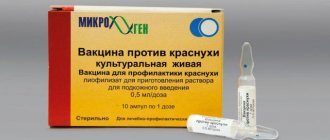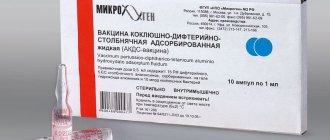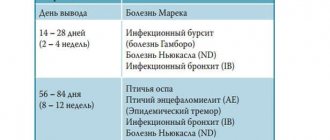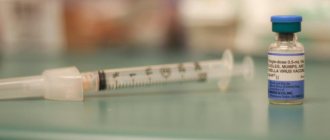What vaccinations are given to children under one year of age?
The first procedure in the vaccination calendar for children under one year of age is scheduled almost immediately after birth - within the first 24 hours of life. As soon as the maternity hospital specialists dry, swaddle, weigh the child and carry out other necessary measures, he will be vaccinated against viral hepatitis B. This disease threatens severe liver damage and is especially dangerous in infancy, which explains such a rush.
Next on the schedule will be a vaccination against tuberculosis - it is done every 3-7 days. Then the frequency of preventive procedures decreases slightly. In total, the vaccination calendar for up to a year includes 13 vaccinations against the following infections (there are fewer positions in the list, because many vaccinations are repeated):
- viral hepatitis B;
- tuberculosis;
- pneumococcal infection;
- diphtheria;
- whooping cough;
- tetanus;
- polio;
- measles;
- rubella;
- mumps (mumps).
The vaccination schedule for some children may be expanded - up to 18 vaccinations. Children at risk for hepatitis B are prescribed additional vaccinations against this infection. Babies diagnosed with certain serious diseases are vaccinated against Haemophilus influenzae.
What vaccinations are prescribed a year and later?
By 12 months, the baby is vaccinated against all dangerous infections, and in the future he only requires rare revaccinations. The vaccination calendar from one to 3 years of age includes only four visits to the doctor (five if the baby is at risk for hemophilus influenzae infection).
The next three repeated vaccinations are given to children before school - at 6–7 years old. Two more will need to be done at age 14. That's all!

How to reduce the likelihood of complications
All vaccines are low reactogenic, meaning the chance of developing side effects is very low. However, they are possible, so patients would like to further reduce possible risks. Often such consequences depend on the patients themselves. To reduce the possibility of complications, it is recommended:
- Before vaccination, get examined and prepared. This is a very important part of the entire process that is often neglected. Vaccinations have their own contraindications and it is very important to identify them before the process itself. It is necessary to be examined to find out if there is an allergy to one of the components of the vaccine or to the excipients that are included in the composition, or the presence of a disease incompatible with the vaccine.
- Consult with your doctor which vaccine you plan to administer, what its possible consequences are, what to do with them, and how long the injection will last. In short, good preparation will reduce the number of unnecessary worries.
- 2-3 days before vaccination, you should avoid crowded places to prevent infection with influenza, acute respiratory infections or acute respiratory viral infections. Also, for 3 days after the procedure, you should avoid contact with large numbers of others.

You can wash and walk after the vaccine. It is recommended to take a shower rather than a bath, and walk in non-crowded places. Before the injection and for the first time after the injection, it is also important not to contract another infection. It is advisable for adults not to drink alcohol before undergoing tests and vaccinations.
What is included in the national vaccination calendar?
On March 21, 2014, the Ministry of Health of the Russian Federation published an order “On approval of the national calendar of preventive vaccinations and the calendar of preventive vaccinations for epidemic indications.” In subsequent years, minor changes were made to it, and today the official vaccination schedule for children in Russia looks like this.
| First day of life | Against viral hepatitis B |
| 3–7 days | Against tuberculosis In most cases, the BCG vaccine is used for this vaccination for newborns, and the gentle BCG-M4 vaccine is used for premature babies. |
| 1 month | Second vaccination against viral hepatitis B |
| 2 months | Third vaccination against viral hepatitis B (risk group) The baby is at risk if his mother or other family members have had viral hepatitis B. Against pneumococcal infection |
| 3 months | Against diphtheria, whooping cough, tetanus This combination vaccine is commonly known as DPT5 (adsorbed pertussis-diphtheria-tetanus). Against polio For the first and second vaccinations, an inactivated (sparing) polio vaccine is used6. Against hemophilus influenzae infection (risk group) This vaccination is not given to everyone. The risk group includes premature babies, children with certain diseases of the nervous system, immunodeficiency, cancer, certain anatomical defects, and babies born to mothers with HIV infection. |
| 4.5 months | Second vaccination against diphtheria, whooping cough, tetanus Second vaccination against Haemophilus influenzae infection (risk group) Second vaccination against polio Second vaccination against pneumococcal infection |
| 6 months | Third vaccination against diphtheria, whooping cough, tetanus Third vaccination against viral hepatitis B Third vaccination against polio Second vaccination against pneumococcal infection Third vaccination against Haemophilus influenzae (risk group) Starting from the third vaccination, healthy babies are given a live vaccine. Children with serious illnesses continue to be vaccinated with the inactivated vaccine. |
| 12 months | Against measles, rubella, mumps This combination vaccine is known as MMR, and mumps is commonly known as mumps. Fourth vaccination against viral hepatitis B (risk group) |
| 15 months | Revaccination against pneumococcal infection |
| 18 months | First revaccination against polio First revaccination against diphtheria, whooping cough, tetanus Revaccination against hemophilus influenzae (risk group) |
| 20 months | Second revaccination against polio |
| 6 years | Revaccination against measles, rubella, mumps |
| 6-7 years | Second revaccination against diphtheria, tetanus The whooping cough vaccine is no longer required, so a different vaccine is used for the second and third diphtheria and tetanus boosters. It is also characterized by a reduced content of antigens. Revaccination against tuberculosis The BCG-M vaccine is not used at this age; only BCG is used. |
| 14 years | Third revaccination against diphtheria, tetanus Third revaccination against polio |
In addition to those listed in the table, the national vaccination calendar includes vaccination of children against influenza. It is not tied to a specific age, because it is impossible to obtain lifelong immunity from all possible current and future strains of influenza. It is recommended to take an injection against this harmful disease when there is an increased epidemiological danger, usually in mid-autumn. Vaccinations can be carried out even for children under one year old, starting from 6 months of age.

Why are these particular diseases included in the vaccination schedule for children?
Because the Ministry of Health rightly considers them the most dangerous existing infections, and this is confirmed by the entire history of human civilization. Over the past centuries, these diseases have accounted for countless billions of dead and disabled people. Even today, this account is not closed, so keeping up with your children's vaccination schedule is extremely important!

Don’t believe it if someone says that the Ministry of Health has inflated the childhood vaccination calendar too much, while in other countries children are vaccinated against fewer diseases. In fact, the position of Russian healthcare is quite conservative. The World Health Organization (WHO) vaccination schedule for children is even longer. It also includes vaccination against the following infections.
| 6 weeks | Vaccination against rotavirus infection. 2 or 3 vaccinations at 4-week intervals, depending on the vaccine. Rotavirus infection, also known as “stomach flu,” causes infectious diarrhea with severe consequences. Every year, this disease kills about 450 thousand children under 5 years of age worldwide. WHO recommends including vaccination against it almost at the very beginning of the vaccination calendar - immediately after viral hepatitis B and tuberculosis. |
| 9 months | Vaccination against meningococcal infection. 2 vaccinations 12 weeks apart. Meningococcal infection can be severe and can lead to very serious complications, including deafness, epilepsy, impaired mental development, gangrene of the fingers, feet, and ears. Russia is not part of the “meningitis belt,” but cases and even outbreaks of the disease are registered regularly. In particular, meningococcus is brought by travelers; one of the stable channels of infection supply is pilgrims who performed the Hajj to Mecca |
| 12–18 months | Vaccination against chickenpox. 2 vaccinations at intervals of 1 to 3 months, depending on the vaccine. The familiar chickenpox easily passes in children, but if you catch it as an adult, the consequences can be very serious. That is why parents wait and rejoice when their child gets chickenpox. But why expose the baby’s body to an attack by a wild virus, if you can be vaccinated with a weakened virus in the first year of life? |
| 9 years | Vaccination against human papillomavirus (girls only). 2 vaccinations with an interval of 6 months. Human papillomaviruses are responsible for causing cervical cancer13 and pose a significant risk to a woman’s health and life. Every year, 240 thousand women die from cervical cancer worldwide. The infection is transmitted through sexual contact, and even the use of condoms does not provide complete protection. WHO recommends that vaccination against this virus be included in the vaccination schedule for children and done as soon as possible after 9 years of age. |
What should I do if I want to expand the vaccination schedule for my children?
Do you want to follow WHO recommendations by adding additional vaccinations to the official vaccination schedule up to a year and at a later age? Nothing is impossible! Vaccinations against rotavirus, meningococcal infections, chickenpox and human papillomavirus are not yet included in the national vaccination calendar, but the vaccines themselves are registered in our country, approved by the Ministry of Health and are available for use.
The delay in the introduction of these vaccines does not mean that Russian doctors have not yet been convinced of their safety and effectiveness. The only thing is that the healthcare system needs time to resolve organizational and financial issues (for example, one dose of the vaccine against the human papillomavirus costs about 7,000 rubles, and on a national scale we are talking about billions). But work in this direction is underway: Health Minister Veronika Skvortsova promised that vaccinations against rotavirus and chickenpox will be included in the national schedule as early as 2020.
Some regions are not waiting for a decision from the federal center and are proactively introducing vaccination against these diseases into their own vaccination calendars. The Orenburg region has become a pioneer in vaccination against rotavirus infection, and other regions are starting to follow suit. Vaccination against the human papillomavirus is carried out in the Moscow region, Khanty-Mansiysk Okrug, Chelyabinsk, and St. Petersburg. There are also regional initiatives regarding chickenpox and meningococcal disease.
Find out which vaccinations from the extended list you can get for free at your place of residence. If some of them are not yet included in the calendar of your region, contact your doctor for paid vaccination.

What if we missed some vaccinations before the year?
This sometimes happens - due to the baby’s illness, forced departure and other reasons. If you have not completed any primary or repeated vaccinations on time, contact your doctor so that he can adjust your child’s vaccination schedule. Each vaccine has its own schedule of administration at certain intervals, so postponing it to a later date will also delay the next vaccinations.
But, of course, it is advisable not to skip vaccinations. Always remember: they are the basis for a long, healthy and happy life for your child!

Pros and cons of vaccination
Any vaccine works on the principle of “accustoming” the body to foreign proteins that cause diseases that are dangerous to health and even life. Deactivated parts of bacteria or viruses, entering the blood, force the immune system to react, remember, in order to subsequently identify and neutralize the aggressor. Some vaccines provide lifelong and 100% protection against a specific disease, while others do not protect completely, but greatly reduce the intensity of the disease.
In some cases, the vaccine is given immediately after contact with a foreign protein - after a dog bite, for example.
Pros of vaccination:
- immunity against specific life-threatening diseases - hepatitis, tuberculosis, polio, rubella and others;
- the opportunity to get sick in a milder form - vaccines do not protect 100% from rubella, whooping cough and other diseases, but in case of infection they are mild;
- protection from epidemics - diseases that had already been eradicated thanks to widespread vaccination in Soviet times are now returning again due to parental refusal.
Disadvantages of vaccinations:
- complications - increased body temperature, decreased immunity to infections, reactions at the injection site (hardening, redness), development of the disease for which the vaccine was given, often in a mild form;
- individual intolerance or allergic reactions to vaccine components - aluminum hydroxide, mercury, formaldehyde.
Considering the possible complications, many parents doubt whether to vaccinate their child up to a year or wait “until better times.” The decision to vaccinate the baby or not lies entirely with them - they need to weigh the pros and cons, show the child to a specialist, and get tested if necessary.











